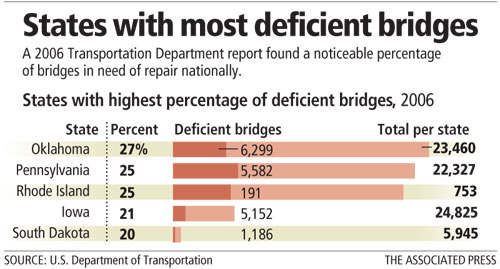Nevada officials confident of quality of bridges
CARSON CITY -- State Department of Transportation bridge engineers said Thursday that a bridge collapse such as the one Wednesday in Minneapolis probably could not happen in Nevada.
"We have a real aggressive bridge inspection program," said Rick Nelson, assistant director of operations for the Transportation Department. "I can say with some confidence that it probably won't happen here."
Bridge engineer Marc Grunert added that Nevada has closed only two bridges in the last 25 years because they posed a danger to the traveling public. The Weeks bridge over the Carson River on U.S. Highway 95 near Yerington was shut down in 1986, and a bridge on a street in Winnemucca was closed in 1984. Both were rebuilt.
Nevada has only one steel deck-truss bridge like the one over the Mississippi River that collapsed in Minnesota. The bridge on U.S. Highway 93 over Meadow Valley Wash in Caliente is small and hardly can be compared with the 1,900-foot-long Minnesota bridge, according to transportation officials.
The Caliente bridge has four truss lines as opposed to the two for the Minnesota bridge. The Federal Highway Administration on Thursday urged state transportation departments to conduct inspections of bridges that are similar in construction characteristics to the one that collapsed in Minnesota.
Nevada's 1,764 state, county and city bridges last January were rated as the best in the nation by Better Roads magazine.
Using Federal Highway Administration reports, the magazine for engineers found that only 69 -- or 4 percent of the bridges in the state -- were functionally or structurally obsolete. That compares with a national average of 25 percent.
Thirteen percent of the bridges in Minnesota were rated as functionally or structurally obsolete.
Nelson said weight and vehicle size restrictions sometimes are imposed on bridges considered functionally or structural obsolete. They are inspected more frequently but do not necessarily have to be closed, he added.
Typically, bridges in the state are inspected once every two years. The primary reason for bridges to be classified as deficient is erosion around the foundations. Mark Elicegui, chief bridge engineer for NDOT, said the agency does not have a specific timetable for replacing the 69 obsolete bridges.
"They have been prioritized," Elicegui said.
"When we have a project in their area, we look at improving them."
"They are not going to fail or fall down," Nelson added.

















